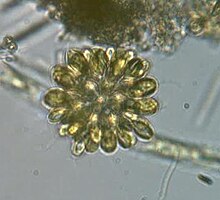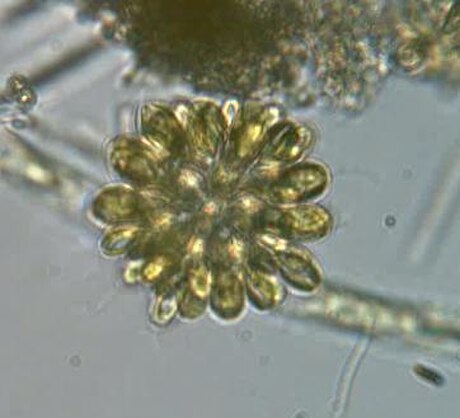Synura is a genus of colonial chrysomonad algae covered with silica scales.[3] It is the most conspicuous genus of the order Synurales.[4]
| Synura | |
|---|---|
 | |
| A colony of Synura sp. | |
| Scientific classification | |
| Domain: | Eukaryota |
| Clade: | Diaphoretickes |
| Clade: | SAR |
| Clade: | Stramenopiles |
| Phylum: | Gyrista |
| Subphylum: | Ochrophytina |
| Class: | Chrysophyceae |
| Order: | Synurales |
| Family: | Synuraceae Lemmermann, 1899 emend. B.Y. Jo, J.I. Kim, W. Shin, P.Škaloud & P. Siver, 2016[1] |
| Genus: | Synura Ehrenberg, 1834 |
| Species | |
| Synonyms[2] | |
| |
Description
Species of Synura form microscopic, spherical colonies, composed of multiple cells attached to each other at the center of the colony. Synura cells are variously shaped, typically spherical to pear-shaped or club-shaped. Each cell contains two plastids aligned with the long axis of the cell; they impart a distinctive golden color to the cells, which comes from chlorophyll c1 and fucoxanthin. Cells are covered with scales made of silica. Two flagella are present.[5]
Identification of species depends on the morphology of the scales. For many species, a positive identification is only possible with an electron microscope, either with scanning electron microscopy (SEM) or transmission electron microscopy (TEM).[5]
Classification
Synura is the type and only genus in the family Synuraceae.[1] The present taxonomy recognizes five sections:[3][4]
- Section Peterseniae
- S. americana
- S. australiensis
- S. borealis
- S. conopea
- S. glabra
- S. heteropora
- S. hibernica
- S. laticarina
- S. longisquama
- S. macracantha
- S. macropora
- S. petersenii
- Section Spinosae
- S. curtispina
- S. mollispina
- S. nygaardii
- S. sphagnicola
- S. spinosa
- Section Echinulatae
- S. biseriata
- S. echinulata
- S. leptorrhabda
- S. mammillosa
- S. multidentata
- Section Splendidae
- S. splendida
- Section Uvellae
- S. uvella
References
Wikiwand in your browser!
Seamless Wikipedia browsing. On steroids.
Every time you click a link to Wikipedia, Wiktionary or Wikiquote in your browser's search results, it will show the modern Wikiwand interface.
Wikiwand extension is a five stars, simple, with minimum permission required to keep your browsing private, safe and transparent.
